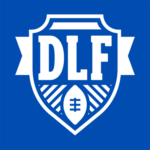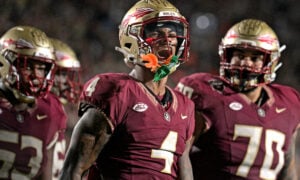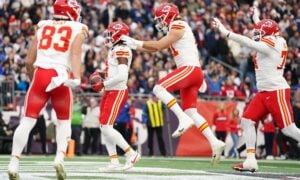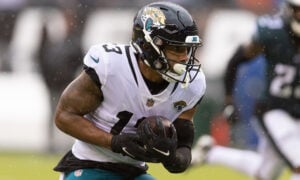2016 Wide Receiver Combine Analysis – Part Three
The NFL draft has finally arrived and rookie draft boards are getting a bit of a makeover this time of year. I’m back in order to attempt to help you break a few of those ties on your own draft board. Before I go any further, you can see that this is part two of a series. If you haven’t read part one yet, stop right now, click the link, and go back to part one. Otherwise, you’re going to be completely lost on what is going on. In fact, even if you already read part one you might want to go back for a quick refresher.
In part one, I outlined the general process I’m using, my goals, my disclaimers and took a look back at recent draft classes to help give you an example of what this metric tells you. I’m going to trust that you actually looked at all of that and get right down to business with the current draft class. I’m going to talk a bit about each prospect and what they bring to the table, both in terms of their physical traits and their other abilities. For the top receivers, I’m going to push them to a special article because they deserve a little extra attention in my eyes.
Keep in mind that a score of a zero is the average for the best wide receivers in the NFL, so there is absolutely nothing wrong with being around zero or even a little bit negative. These receivers were covered in part two of the series. Where I start getting concerned is when a player gets below a -2 and especially when they are below a -4. This is where this part of the series is focusing, those players below -2. The score in the parenthesis is the score without height and arm length factored in for those who feel height is overrated. On with the show!
**Special note: Unlike the first two parts, this part was written with the benefit of knowing the teams these receivers will be playing for in the fall.
[am4show have=’g1;’ guest_error=’sub_message’ user_error=’sub_message’ ]
Slightly Limited Upside (Scores between -4 and -2)
Charone Peake: -2.14 (-3.54)
Jordan Payton: -2.21 (-1.91)
Kayarris Garrett: -2.27 (-4.51)
Sterling Shepard: -2.52 (0.85)
Corey Coleman: -2.60 (0.45)
Cody Core: -3.11 (-3.27)
Kolby Listenbee: -3.89 (-2.22)
In this group we are talking about receivers who are a bit below the top performing receivers in the NFL in terms of physical ability. These are the players who likely fit into one of two categories. Either their upside is going to be limited to a best case of a WR2 but more likely WR3, or they are the smaller receivers this metric is a little harsher on. If it is the latter, then their score without height should be several points higher. Shepard and Coleman are perfect examples. I’ll talk more about both of them in part four of the series. They have positive scores without height, meaning they still have high end upside. As for the rest, they are likely to be capped a bit by their lack of athletic ability. That doesn’t mean they aren’t fantasy worthy, just that they have a little lower ceiling than some others.
Peake is a player I’m seeing come off the board as soon as the early third round in a few leagues. Some people really like him and see the lack of depth behind Brandon Marshall and Eric Decker as a sign of opportunity. I’m not as high on him. He has size and good top end speed, but what he lacks is suddenness. As players like Antonio Brown have shown, that is much more important at times than speed. Peake lacks the ability to start and stop quickly, which hinders his route running ability as well. He can work on them, but he might lack the physical ability to become a great route runner. Combine this with a long list of injuries, and I’m going to let someone else take him in the third round.
The third receiver drafted by the Browns in the draft, Payton is one of the players people are taking a shot at in rookie drafts. Why not give him a try after all? Someone needs to play opposite Coleman, and it doesn’t seem like it is going to be Josh Gordon anytime soon. Payton doesn’t have any glaring weaknesses from a physical standpoint, he is just a little below the norm pretty much across the board. He has massive hands with a decent frame, and he could profile as a chain moving possession receiver for the Browns. He is unlikely to be the down the field threat or the big play guy, but he could still carve out a role and be a WR3/4 type of player with a lot of four catches for 40 yards kind of games.
Garrett is a player many were shocked went undrafted. Yet he is still a fixture in the third round in a lot of fantasy drafts. Exceptionally small hands, especially for someone who is 6’3”, hurt him a fair amount in this metric. He also had an extremely poor three cone drill, which signals he struggles to keep his speed while changing directions. This is also seen in his route running, which is an area in which he definitely seems to struggle. He’s going to need to work really hard to change this if he wants to be successful at the NFL level. He definitely has talent, but there was clearly a reason every NFL team passed on him multiple times, so don’t spend too much to get him.
A sixth round pick by the Bengals, Core was LaQuon Treadwell’s wingman the past few seasons. He didn’t fully participate at the combine, so his score is incomplete. From what he did do, he is extremely lean and not overly explosive. He does have a tall frame with large hands though. I think he is likely to be a part time player as a receiver in the NFL, likely only seeing the field in special situations or as the fourth receiver. He’s going to need to play on special teams to keep his chances alive.
Another sixth round pick, but this time by Buffalo, Listenbee is a former track star. He was drafted by the same team who spent a much earlier pick on Marquise Goodwin. He didn’t fully compete at the combine either, but he did show a lean build and miniature hands to go with short arms. On the plus side, he did manage a sub 4.4 time in the 40 yard dash, but that was expected from him. He’s pretty much a one trick pony. He can’t run many routes, so he’s primarily just a deep threat and potential return man for the Bills. Much like Core, Listenbee isn’t worth fantasy consideration.
Larger Concerns (Scores between -6 and -4)
DJ Foster: -4.06 (-0.79)
Chris Brown: -4.30 (-4.22)
Cayleb Jones: -4.69 (-5.47)
Pharoh Cooper: -4.85 (-3.48)
Roger Lewis: -4.91 (-3.76)
Johnny Jolton: -5.22 (-5.24)
Tyler Boyd: -5.81 (-5.09)
Rashawn Scott: -5.93 (-4.69)
This is the point when I start to get really concerned. Almost no one in this range or lower, who actually completed all of the combine drills, ends up turning into a WR2 or better. The only exceptions are those players who are very undersized. Think about guy like TY Hilton. Anyone else who wasn’t on the extreme when it comes to physical size doesn’t seem to pan out. That’s concerning with highly drafted Tyler Boyd in this group. I’ll address him specifically in part four. Foster, Cooper, and Lewis are the three in this group who seem like they could be the size exceptions, since their score without height factored in is more than a point higher, so let’s start there.
Foster is short, but well-built for his size. He has great speed when changing directions and a very quick first step, but his top end speed is a little lacking. He spent most of his time during college at the running back position before transitioning to receiver, but I think his athletic abilities fit with the running back position more. He was undrafted, but later signed with the Patriots, so who knows what position he could be playing. Look elsewhere for fantasy relevance.
Cooper is going to be in the mix with an awful lot of other receivers when it comes to the Rams starting lineup. It is anyone’s guess who will emerge from the fog during training camp. Regardless, having a rookie quarterback at the helm normally isn’t a recipe for fantasy success. Cooper’s score would have been much better had he actually completed the combine. He did the jumps, which were pretty bad, but he would have likely excelled in the shuttle and cone drills. I think he likely would have been a point or two higher had he done those.
Lewis is another player who went undrafted before eventually landing with the Giants. He didn’t fully compete at the combine. He claims he injured himself and pulled out of a lot of the drills. I’m inclined to believe him given massive improvements at his pro-day from what he did during the combine. The major question for Lewis is maturity. He had some off the field issues, but performed well on the field. If he can keep his nose clean, he could work his way up a rather weak depth chart. He’s someone to watch as OTAs and mini-camps play out. He might be worth a flier.
As for the rest of this group, they don’t seem to have the physical profile to make it in the NFL. NFL teams seem to agree since they all went undrafted. I wouldn’t give any of them a second look in your drafts.
Other Notable Players (Below -6)
Kenny Lawler: -6.36 (-7.23)
Will Fuller: -6.46 (-4.26)
Rashard Higgins: -7.39 (-6.88)
De’Runnya Wilson: -9.23 (-11.82)
Tajae Sharpe: -9.48 (-9.41)
There were a lot of players in this draft class who fell into this range. Many of them went undrafted or in the very late rounds and will be lucky to make their respective teams as special team players or training camp bodies. Much like the previous group, players in this range almost never make a significant impact on fantasy squads because they lack the ceiling to be weekly starters or often times even flex plays. There were a few bigger names in this group, which are the five you see. Fuller is of course the biggest name, and I’ll be talking about him in the final part of this series, but let me talk about the others.
Lawler has received a bit of attention after being drafted by the Seahawks due to their terrible lack of depth at the position. He was one of Jared Goff’s top targets at Cal, and I think Goff made him look better than he really is. I’m not saying Lawler is terrible, because he does run really nice routes, he just doesn’t have the athletic ability to play at the next level. He’s slow and lacks explosiveness. I don’t think he has the talent to see the field on a regular basis.
Another one of the rookie Browns, Higgins is likely to be on the outside looking in at a starting spot when the season rolls around. He’s exceptionally lean for his height, doesn’t jump well, and he’s slow. That’s a combination which doesn’t work in the NFL. He does have great hands, but if he can’t get open and can’t win at the point of the catch due to being overpowered by corners, there isn’t much place for him on the field.
Of the five, if I had to take a chance on someone not named Fuller, I would definitely go with Sharpe. He didn’t fully compete in the combine, so his score is incomplete. Plus, a large portion of his negative score came from an extremely lean build and tiny hands. He can work on the build, and the same hands don’t seem to impact his play. He’s a hard worker, great route runner, and was highly productive in college. It will take a year or two for him to grow into his frame, but with his work ethic he should eventually see the field. The upside isn’t huge, but he might be able to push for WR3 numbers if everything goes perfectly.
I left Wilson for last because his -11.82 score when you take his massive height out of things is one of the lowest I’ve seen in the five years I’ve been doing this. What is even more concerning is if he had completed all of the drills at the combine he would have been even lower. He was one of if not the lowest performer on all of the drills he did complete. There is basically zero chance he turns into anything in the NFL.
That’s it for the field. The fourth and final part of the series will have a breakdown of the top receivers in this class, complete with a more detailed look at their scores and how I view them moving forward. Be sure to check back for that. Thanks for reading!
[/am4show]
- Final 2021 Pre-Draft Rookie Mock: Round Three - April 28, 2021
- Final 2021 Pre-Draft Rookie Mock: Round Two - April 26, 2021
- Final 2021 Pre-Draft Rookie Mock: Round One - April 25, 2021


































































